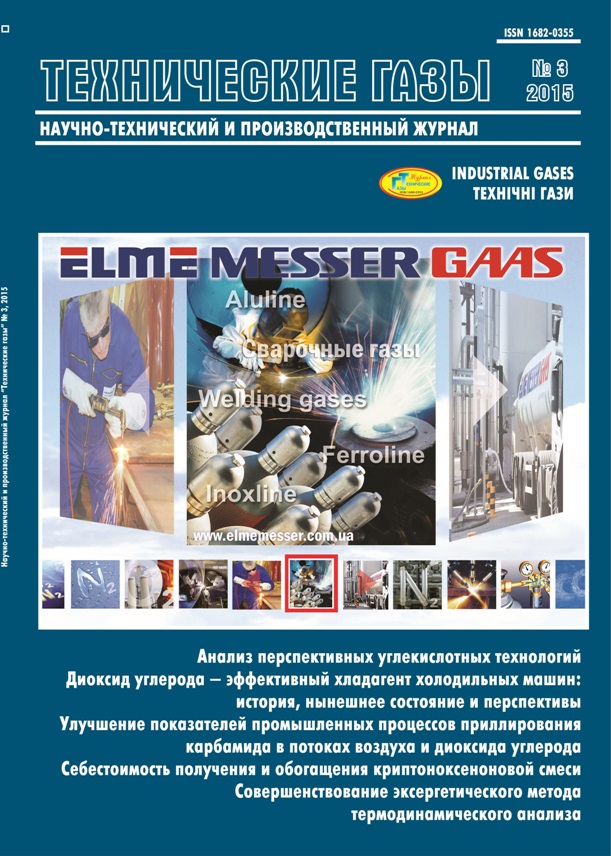ИСПОЛЬЗОВАНИЕ ДИОКСИДА УГЛЕРОДА КАК ЭФФЕКТИВНОГО РАБОЧЕГО ТЕЛА В ХОЛОДИЛЬНЫХ МАШИНАХ: ИСТОРИЯ, НЫНЕШНЕЕ СОСТОЯНИЕ И ПЕРСПЕКТИВЫ
DOI:
https://doi.org/10.18198/j.ind.gases.2015.0775Ключевые слова:
Холодильная машина, Тепловой насос, Натуральные холодильные агенты, Диоксид углерода, Холодильный коэффициент, Коэффициент преобразования, Степень термодинамического совершенства, Компрессор ВорхисаАннотация
В качестве рабочих веществ парокомпрессорных холодильных машин (ПХМ) и тепловых насосов (ТН) можно использовать различные газы. К ним относятся не только специально синтезированные химические соединения, но также и натуральные хладагенты — аммиак, диоксид углерода, углеводороды. Описаны холодильные циклы, пригодные для работы на диоксиде углерода (R744). Рассмотрены докритические, транскритические, дроссельные, дроссельно-детандерные и каскадные циклы, в ко-
торых диоксид углерода применяется в качестве хладагента низкотемпературного контура. Уделено внимание анализу достоинств углекислотного цикла, в состав которого включён компрессор Ворхиса. Приведено сравнение характеристик дроссельных циклов с различной температурой охлаждения, одно- и двухступенчатым сжатием. Изложена краткая история создания холодильных установок и тепловых насосов, работающих на CO2, указаны основные их производители, выпускающие оборудование с учётом особенностей используемого рабочего вещества. Отмечены преимущества систем тепло- и хладоснабжения, работающих на диоксиде углерода, по сравнению с системами, использующими альтернативные холодильные агенты.
Библиографические ссылки
Hovalyig D.M., Sinitsyin K.M., Baranenko A.V., Tsoy A.P. Energy efficiency and environmental safety of low-temperatures engineering// Science Magazine NIO ITMO. Series «Refrigeration and Air Conditioning». — 2014. — № 1 [Electronic resource]. Access code: http://www.inbt.itmo.ru/ articles/1058.pdf. (Rus).
Tsvetkov O.B. Refrigerants, refrigerants and refrigeration oils — nostalgia for the future [Electronic resource]. Access code: http://holodko.ru/freon/Tsvetkov_Themophys.pdf. (Rus).
Fisher S.K., Fairchild P.P., Hughes P.S. Global warming implications replacing CFC//ASHRAE Journal. — 1992. — April. — P.14–19.
Zheleznyiy V.P., Semenyuk Yu.V. (2012). Working body parokompressornyh chillers: properties, analysis and application. — Odessa: Feniks. — 420 p. (Rus).
NIST Reference Fluid Thermodynamic and Transport Properties (REFPROP. Version 9.1): [U.S. Department of Commerce]// National Institute of Standards and Technology. — Gaithersburg, Maryland, 2013.
Dossat R.J., Moran T.J. (2001). Principles of Refrigeration. —Upper Saddle River, — 454 p.
Vaynshteyn V.D., Kantorovich V.I. (1972). Low-temperature refrigeration units. — М.: Food production. — 351 p.
Martyinovskiy V.S., Meltser L.Z. (1964). Ship refrigeration units. — М.: Transport, — 383 p.
Martyinovskiy V.S. (1950). Chillers. — М.: Pischepromizdat. — 256 p. (Rus).
Kharlampidi D.H., Sherstyuk A.V., Bratuta E.G. (2011). Thermodynamic analysis of supercritical cycle refrigerating machines and heat pumps// Energy saving. Energy. Energy audit. — № 8 (90). — P. 43–48. (Rus).
Lavrenchenko G.K., Khmelnyuk M.G. (2003). The perfection of refrigaration machine with refrigerant recharging of compressor’s cylinder. 1. The Production of cold at one lever of temperature// Tekhnicheskie Gasi. [Industrial Gases]. — — № 2. — P. 16–24. (Rus).
Lavrenchenko G.K., Khmelnyuk M.G. (2003). The perfection of refrigaration machine with refrigerant recharging of compressor’s cylinder. 2. The Production of cold at two levels of temperature// Tekhnicheskie Gasi. [Industrial Gases]. — № 4. — P. 16–19. (Rus).
Cooling systems CO2 for food retail stores. Design subcritical and transcritical CO2 systems and the selection of the necessary equipment, produced company «Danfoss»// LTD «Danfoss». — 2009 [Electronic recurs]. access code]. access code: www.danfoss.com/ СО2. (Rus).
Gorbenko G.A., Chayka I.V., Gakal P.G., Turna R.Yu. (2009). Application of carbon dioxide in refrigerating technologies// Tekhnicheskie Gasi. [Industrial Gases].— № 4. — P. 18–22. (Rus).
Kalnin I.M., Pustovalov S.B., Krivtsov D.V. (2013). The scale and prospects of using heat pumps R744// Kholodilnaya tehnika. [Refrigeration Engineering]. — № 3. — P. 22–26. (Rus).
Tovazhnyanskiy L.L., Kapustenko P.A., Havin G.L. (2007). Features of the application of the refrigerant CO2 (R744) in heat pumps// Integrated technologies and energy efficiency. — № 3. — P. 23–26. (Rus).
Pustovalov S. Heat pumps of the new generation on the carbon dioxide (R744)// Bulletin of the Russian Academy of Natural Sciences. — № 1. — P. 81–86. (Rus).
Suhodolskaya A.B., Kochetov V.P. (2006). Environmental and energy analysis of prospects for the application of alternative refrigerants in the heat pumps// Kholodilnaya teh-nika i tehnologiya. [Refrigeration Engineering and Techno-logy]. — part 2. — № 4 (102). — P. 77–84. (Rus).
Dyachenko O.V. (2006). The use of natural refrigerants in the systems of heat and cold processes// SОК. — №10 — P. 98–101. (Rus).
Viman U. The complete elimination of useless losses (2010). // Informatsionnyiy byulleten po holodilnyim siste-mam. — №1. — P. 4–5. (Rus).
[Electronic resource]. Access code: www.danfoss. com/ nr/ rdonlyres/ 4a74d6ca-c8ba-4f44-bc09-e8cdec334cff/1669/kom_co3.pdf.
[Electronic resource]. Access code: http://uash. com.ua/ files/bitzer20years.pdf.
Kozmalov S.N., Bonfanti M. (2014). Usage of Dorin compressors in CO2-technologies // Kholodilnaya tehnika. [Refrigeration Engineering]. — № 2. — P. 28–31.
Загрузки
Выпуск
Раздел
Лицензия
ЛИЦЕНЗИОННЫЙ ДОГОВОР
После приёма статьи к публикации редакция согласно требованиям наукометрических баз каждому из авторов направляет лицензионный договор об уступке и передаче в управление авторских прав. Подписи автора (авторов) желательно скрепить печатью отдела кадров учреждения, в котором работает автор (авторы), или печатью факультета.
Редакция отсылает авторам одну верстку для корректуры. Допустимы лишь те исправления, которые приводят верстку в соответствие с исходным текстом статьи. Внесение существенных изменений не допускается. Верстку следует выслать в редакцию в течение суток с момента получения.

